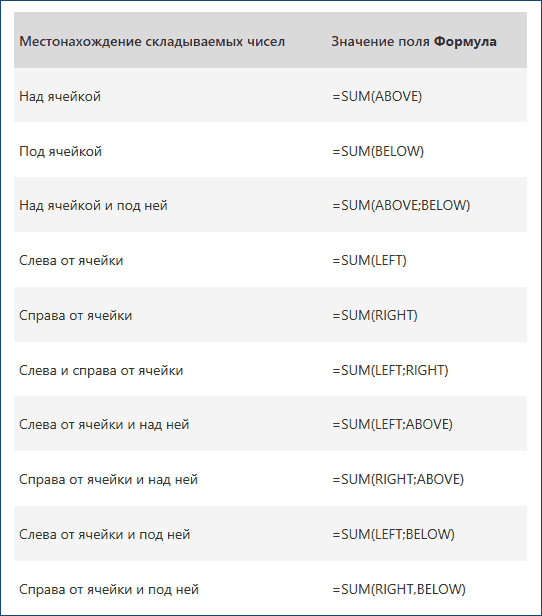Calculating the amount in a table in a Word document

Hello friends! When creating text documents in the Word editor, we can add tables to them. I already wrote about this on the blog pages, and many readers asked me how to calculate the sum of numerical values in a table in a Word. Let's talk about it today.
Calculation of the sum in the cells of the table
The word processor has the ability to perform simple calculations in tables using special formulas. For example, let's take a simple table for calculating sales of computer equipment in stores. See the picture below.
Let's calculate the values of the total and everything. You can calculate the amount using formulas. Click in the cell of the table where you want to display the result of the calculation (line Total). In the toolbar, select the command Formula, which is located in the section on the tab Layout in Group Data.
The Insert Formula dialog box will appear, which will already have the formula for calculating the sum in the "=SUM(ABOVE)" column.
 Window for inserting sum formula in word
Window for inserting sum formula in word We don't change anything here, just click OK.
Numerical data for summation will be taken from the top cells of the corresponding column. The target cell will display the result of the calculation, not the formula.
Attention! The table must be populated with data. If some value is missing, then it is necessary to put the number zero in the cell. Otherwise, the count will be performed up to the first empty table cell.
Calculating the sum in horizontal cells (column Total) is carried out in a similar way, but the formula must be changed in the dialog box. To calculate the sum of numbers to the left of the cell with the result, you must write the formula "=SUM(LEFT)". If the numbers are on the right - "=SUM(RIGHT)"
To calculate the sum of numbers in other directions, use the table below.
 List of sum function parameters
List of sum function parameters Updating Calculation Results by Formulas
Unlike spreadsheets, updating calculated values in a Word document occurs when it is opened or is forced. If you have changed the numbers in the table, then you need to manually update the following items:
- calculated results of some formulas;
- results in the selected table.
Update totals for a selected formula
Highlight the value previously calculated by the formula that you want to update. Press key F9.
Update the results of all formulas in a table
Select the entire table that contains the results of the formulas you want to update and press the F9.
By the way, in addition to the sum, you can calculate product, mean, and number of numeric values. To do this, use the corresponding functions =PRODUCT(LEFT), =AVERAGE(RIGHT), =COUNT(LEFT). In parentheses, as a parameter, the direction of calculation relative to the cell with the formula is indicated. This parameter can be changed, just like the sum function, see the figure above.
A word processor is primarily intended for writing texts, so if large amounts of calculations are required in a table, then you must use Microsoft Excel or a similar program, for example, Calc from .
How to quickly fold a column
With a large number of columns in which you want to add numbers, you can speed up the output of the sum. To do this, in the bowels of the Word, you need to dig out the amount button and add it to the quick access panel. Look at the picture below. Click on the dropdown list and select an item Other commands.

In the next window (see below), in the drop-down list (highlighted in red frame), select All teams. And in the lower field, scrolling through the list, we find the item Sum. Click Add to place this button on the Quick Access Toolbar. click OK.

Now calculating the sum in a column or row will be as easy as shelling pears. Place the cursor at the bottom of the column below the numbers and click the button Sum. Now it's on the Quick Access Toolbar. The result will appear immediately.
When using the button Sum remember: calculation priority is given to the column, not the row. If the numbers are to the left and above of the resulting cell, then the numbers of the top cells will be added.
Therefore, to calculate the sum by rows, you need to go to the trick. First, we sum up the bottom line, and then we rise higher.
I hope you find the article useful. I will be glad to your comments. And also do not forget to share the article with your friends and subscribe to blog updates.
Dear reader! You have read the article to the end.
Did you get an answer to your question? Write a few words in the comments.
If no answer is found, indicate what you are looking for.